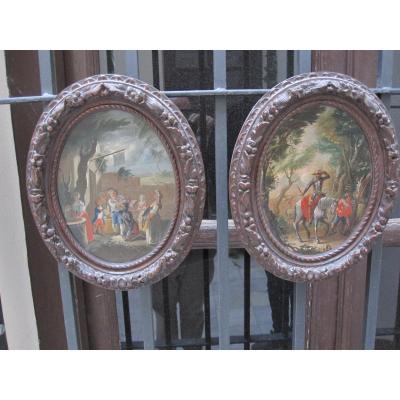Our painting illustrates an episode from Greek mythology depicting the moment when the nymph Arethusa is enveloped in a thick swirling fog to escape the river god Alpheus (or Alpheus) who is pursuing her. While running, the latter surrounds the cloud, thinking of embracing the beauty that is fleeing from him. In order to accentuate the centripetal movement of the composition, the gestures and looks of the other protagonists (reclining river divinity, nymphs crowned with flowers and leaves and putti) are oriented towards the couple. This baroque work is a synthesis of the “Disegno-Colore” (drawing-color) debate which pitted painters against each other since the 16th century. And this, in Rome more than in Tuscany. From the 1660s, and after the death of Andrea Sacchi, Carlo Maratta's compositions freed themselves from a certain austerity, opening up to the classical movement which was circulating at the time. His painting then becomes more decorative, displaying a colorful palette and a more flexible brush. Thus, our painting can be compared to other works by Carlo Maratta from this period: Apollo chasing Daphne (1681, Royal Museums of Fine Arts in Brussels) or The Discovery of Remus and Romulus (between 1680 and 1692, Palais du Sans-Souci, Potsdam).
We have chosen to present this painting to you in an elegant Italian frame in carved and gilded wood with foliage decorations.
Dimensions: 64 x 49 cm – 79 x 64 cm with the frame
The myth of Alphaeus and Arethusa:
In classical Greece, the gods, in whose hands the destiny of civilization was at stake, inspired numerous legends and myths. The city of Syracuse, heir to Greek culture and traditions, cultivates one of these beautiful legends which tells the myth of Arethusa and Alpheus. Arethusa, favorite of Diana, goddess of hunting and knowledge, was a nymph so beautiful that all men who laid eyes on her ended up desiring her. And it did not take long for Alpheus, river god (located in the Peloponnese) son of the titan Ocean, to succumb to her beauty. After a hunting trip, Arethuse bathed in a river whose waters began to bubble. Frightened by the whirlwinds, the nymph rushed out of the water and Alpheus appeared in his human form showing himself in all his lascivious beauty. Arethusa tried to escape, understanding Alphaeus' desire to make her his. When the nymph was tired of running, in a desperate plea she asked Diana for help: “Turn me into water as far from here as possible.” Diana accepted Arethusa's call and allowed her to hide from Alphaeus' sight in a thick fog, then transformed her into a spring of fresh water on Ortigia (an island near Syracuse). This legend is so ingrained in the culture and history of Syracuse that its inhabitants proudly bear the nickname "aretusei" and a fresh water spring in Ortigia is named "Fountain of Arethusa".
Biography: Carlo Maratta or Maratti (Camerano, Ancona 1625 – Rome 1713) entered the workshop of Andrea Sacchi at a very young age from which he did not leave until 1661 (upon the latter's death). Trained in the study of the works of Raphael and Carracci, he adhered to the classical trend of late Roman Baroque. Protected by Alexander VII, he worked mainly in Rome with formal elegance. He produced large altar paintings (Visitation, 1656, Santa Maria della Pace; Death of Saint-François-Xavier, 1679, Church of Jesus; Glory of Saint-Ambroise and Saint-Charles, 1685-90, San Carlo al Corso ), strong portraits (Maria Maddalena Rospigliosi, Louvre Paris; Andrea Sacchi, Prado Madrid; Cardinal Antonio Barberini, Galleria nationale Rome). And important frescoes (Triumph of Mercy, Palazzo Altieri Rome; Birth of Venus, Villa Falconieri Frascati), which are characterized by their grandiose composition and harmonious chromatic arrangements. His enormous production dominates all Roman art of the late 17th and early 18th centuries.
Bibliophilia
- Maratti and Europa. L. Barroero, S. Schütze, S. Prosperi Valenti Rodino. Publisher Campisano 2015
- Patronage and devotion. A focus on six Roman Baroque paintings. Giovan Battista Fidanza and Guendalina Serafinelli. Publisher Holberton 2022
- Da Rubens a Maratta. The barocco seascape in Marche. Catalogo della mostra (Osimo, 29 January-15 December 2013) vol. 2 - Osimo and the Marca di Ancona. Sgarbi, Vittorio (a cura di). Edited by Silvana Editoriale 2013
- Interpretare Ovidio. Luigi Garzi, he mito di Alfeo e Aretusa e una note su Hinrich Krock, "Amica Veritas". Studi di storia dell'arte in onore di Claudio Strinati, a cura di Antonio Vannugli, Roma 2020, pp. 469-483.


























 Le Magazine de PROANTIC
Le Magazine de PROANTIC TRÉSORS Magazine
TRÉSORS Magazine Rivista Artiquariato
Rivista Artiquariato
